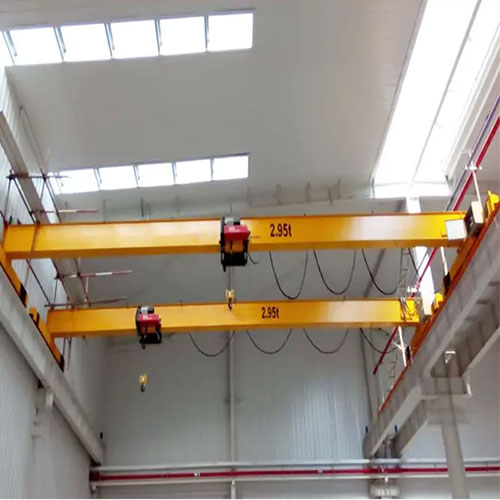Overhead Cranes for Industrial Use| 3T, 5T, 10T, 15 T,20T 30T,40T, 50T
Industrial overhead cranes for sale Yemen. Custom overhead cranes for your industrial needs, cost-effective industrial crane solution design for you!
Category: Yemen
Your Trusted Overhead Crane Manufacturer & Supplier
Overhead Cranes for Industrial Use| 3T, 5T, 10T, 15 T,20T 30T,40T, 50T
Custom Overhead Cranes for Your Industrial Needs, Cost-effective Industrial Crane Solution Design for You
Industrial overhead cranes for sale Yemen. Custom overhead cranes for your industrial needs, cost-effective industrial crane solution design for you!
Comprehensive Guide to Overhead Cranes in Yemen: Finding the Right Fit for Your Industrial Needs
Yemen stands as a diverse landscape where various industries thrive amidst unique challenges and opportunities. In this guide, we'll explore the significance of overhead cranes in Yemen's industrial operations, offering insights into their crucial role and how they cater to specific industrial requirements across the nation.
Overview of Yemen's Industrial Landscape
Yemen's industrial sector encompasses a wide array of industries, including agriculture, fishing, oil and gas, manufacturing, and more. These sectors contribute significantly to the country's economy, providing employment and driving economic growth.
From the lush agricultural lands producing coffee, qat, fruits, and vegetables to the bustling fishing industry along the coastal regions, Yemen boasts a vibrant array of industrial activities spread across different geographical zones. Furthermore, the oil and gas sector, predominantly situated in areas like Marib and Shabwah, plays a pivotal role in fueling the nation's energy demands.
In the filed of material handling and lifting operations, overhead cranes emerge as indispensable tools for various Yemeni industries. These cranes are pivotal in facilitating the movement of heavy loads, streamlining manufacturing processes, aiding in construction projects, and supporting logistical operations in ports and warehouses.
From single girder overhead cranes providing cost-effective lifting solutions to double girder cranes offering robust capabilities for heavy-duty tasks, the versatility of overhead cranes aligns with the diverse needs of Yemen's industrial sectors. Whether it's the precise load movement of top running cranes or the space-saving advantage of wall jib cranes, each type of overhead crane caters to specific industrial requirements.
Overview of Overhead Crane Types
When it comes to selecting the right overhead crane for specific industrial operations in Yemen, understanding the diverse range of crane types available is essential. Let's explore the various overhead crane types tailored to meet different lifting and material handling needs across industries.
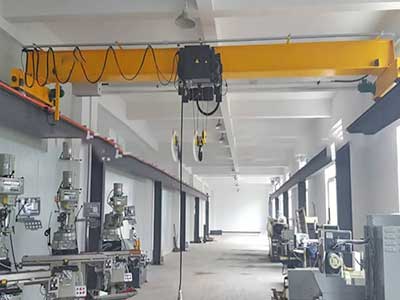
- Crane Design & Capacities: Single girder overhead cranes have one bridge girder and are suitable for lighter lifting applications, typically ranging from 1 ton to 20 tons.
- Tailored Features for Operation in Yemen: These cranes offer cost-effective solutions for handling moderate loads. They are adaptable and suitable for various industries where heavy lifting isn't required.
- Applicable Industries: Single girder overhead cranes find use in manufacturing, warehouses, workshops, and smaller-scale industrial operations.
- Typical Industrial Location & Crane Project Locations in Yemen: Commonly found in smaller industrial setups or manufacturing units across Yemen, especially where moderate lifting needs exist.
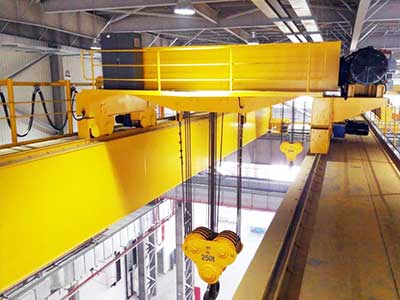
- Crane Design & Capacities: Double girder overhead cranes have two bridge girders and offer higher lifting capacities, usually ranging from 5 tons to over 200 tons.
- Tailored Features for Operation in Yemen: These cranes are designed for heavy-duty lifting, providing stability and precision in handling larger loads. They're suitable for heavy industries and more demanding operations.
- Applicable Industries: Double girder overhead cranes are commonly used in steel mills, foundries, heavy manufacturing, and large-scale industrial operations.
- Typical Industrial Location & Crane Project Locations in Yemen: Found in larger manufacturing facilities, construction sites, or industrial setups requiring heavy lifting capabilities.
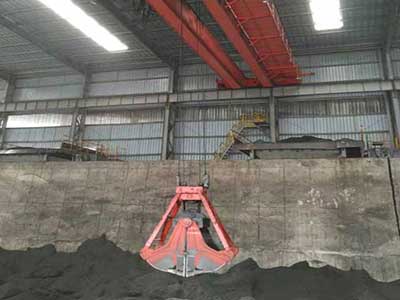
Top Running Overhead Crane
- Crane Design & Capacities: Top running overhead cranes are designed to run along elevated runways and typically offer higher capacities.
- Tailored Features for Operation in Yemen: These cranes provide efficient material handling capabilities, offering smooth movement and precision in lifting and positioning loads.
- Applicable Industries: Top running overhead cranes find applications in various industries where precise load movement is crucial, such as manufacturing, warehouses, and assembly lines.
- Typical Industrial Location & Crane Project Locations in Yemen: Commonly seen in larger manufacturing units, warehouses, or industrial facilities where efficient and controlled material handling is required.
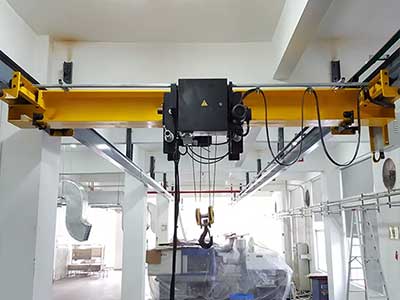
Underhung Bridge Crane
- Crane Design & Capacities: Underhung bridge cranes are designed to utilize underhung runways for movement and lifting. They're often used for smaller capacities ranging from a few hundred kilograms to several tons.
- Tailored Features for Operation in Yemen: These cranes are suitable for facilities where space is limited or where a top-running crane isn't feasible. They can be designed to suit specific operational requirements and space constraints within Yemeni industries.
- Applicable Industries: Underhung bridge cranes are commonly used in workshops, assembly lines, and facilities where overhead space is limited and a more compact crane design is necessary.
- Typical Industrial Location & Crane Project Locations in Yemen: Found in smaller manufacturing units, assembly areas, or workshops where there's a need for localized lifting capabilities. These could be present in urban and industrial zones across Yemen.

- Crane Design & Capacities: Freestanding overhead cranes, also known as free-standing or standalone cranes, are self-supporting structures with supporting columns. They're available in various capacities, ranging from smaller loads to heavier lifting requirements.
- Tailored Features for Operation in Yemen: Suitable for areas where it's challenging to install a crane directly onto the building's structure or where no suitable support structure exists. They are designed to be independent and don't rely on existing building support.
- Applicable Industries: Freestanding overhead cranes are commonly used in outdoor applications, open storage yards, workshops, and areas where installing a crane onto the building isn't feasible or desired.
- Typical Industrial Location & Crane Project Locations in Yemen: These cranes might be found in outdoor construction sites, storage yards, or workshops where a standalone lifting solution is required.
In Yemen, where industrial infrastructure might face challenges due to space constraints or specific site limitations, underhung bridge cranes and freestanding overhead cranes can offer valuable solutions. These crane types provide flexibility in installation, enabling efficient material handling in spaces where traditional overhead crane setups might not be viable.
Given Yemen's diverse industrial landscape and potential limitations in infrastructure, these specialized crane types could find applications in various sectors. However, due to the dynamic nature of Yemen's industrial conditions and ongoing challenges, specific information about the presence or utilization of these cranes might vary and would best be obtained by contacting local crane suppliers, manufacturers, or industry experts familiar with the Yemeni market.
Gantry Cranes
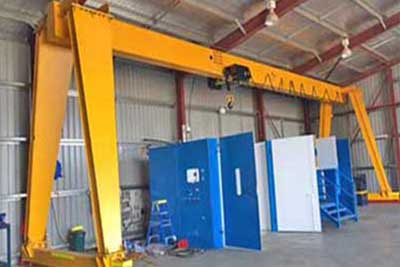
- Crane Design & Capacities: Single girder gantry cranes have a single bridge girder, offering moderate lifting capacities, typically ranging from 1 ton to 20 tons or more.
- Tailored Features for Operation in Yemen: These cranes provide cost-effective solutions for lifting moderate loads. They offer adaptability and flexibility in various industries requiring mobile lifting equipment.
- Applicable Industries: Single girder gantry cranes find utility in construction sites, warehouses, workshops, and smaller industrial setups.
- Typical Industrial Location & Crane Project Locations in Yemen: Commonly used in areas requiring moderate lifting capabilities, such as construction sites, smaller workshops, and certain industrial zones.
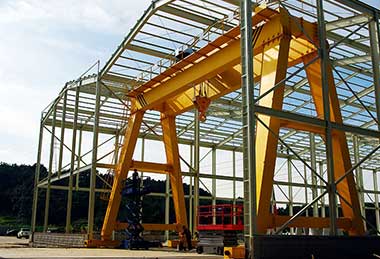
- Crane Design & Capacities: Double girder gantry cranes feature two bridge girders, offering higher lifting capacities, usually ranging from 5 tons to over 200 tons.
- Tailored Features for Operation in Yemen: These cranes are designed for heavy-duty lifting, providing stability and strength for handling larger loads in various industrial applications.
- Applicable Industries: Double girder gantry cranes are commonly used in shipyards, steel yards, heavy manufacturing, and construction projects requiring heavy lifting.
- Typical Industrial Location & Crane Project Locations in Yemen: Seen in larger industrial operations, construction sites, and areas requiring substantial lifting capacities.
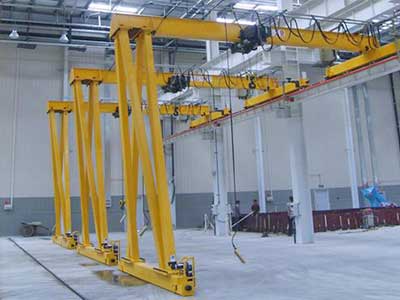
- Crane Design & Capacities: Semi gantry cranes have one end supported by a structure while the other end moves on wheels or rails.
- Tailored Features for Operation in Yemen: These cranes offer a balance between stationary and mobile cranes, suitable for areas with limited space or where a full gantry isn't feasible.
- Applicable Industries: Semi gantry cranes find use in workshops, loading docks, and industrial setups with space constraints.
- Typical Industrial Location & Crane Project Locations in Yemen: Utilized in areas where a full gantry might not be practical, such as workshops or smaller industrial spaces.
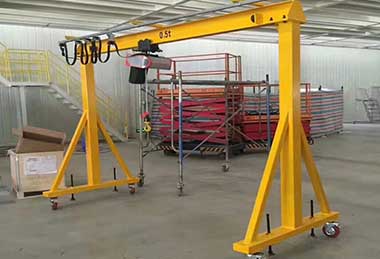
- Crane Design & Capacities: Portable gantry cranes are lightweight and easily movable cranes designed for easy assembly, disassembly, and transportation.
- Tailored Features for Operation in Yemen: These cranes offer mobility and flexibility for lifting tasks in temporary or changing work environments.
- Applicable Industries: Portable gantry cranes are used in maintenance, repair works, loading/unloading goods in smaller workshops, or temporary construction sites.
- Typical Industrial Location & Crane Project Locations in Yemen: Commonly used in smaller workshops, construction sites, and areas requiring temporary lifting solutions.
In Yemen, where industrial conditions might face limitations in infrastructure or space constraints, the versatility of gantry cranes offers solutions for various lifting needs. These crane types provide flexibility, mobility, and varying load capacities, catering to different industrial requirements across sectors.
However, due to the dynamic nature of Yemen's industrial landscape and potential challenges arising from the ongoing situation, specific information about the presence or utilization of these crane types might vary. For precise details about the availability or usage of these gantry cranes in Yemen, consulting local crane suppliers, manufacturers, or industry experts familiar with the Yemeni market would offer the most accurate and current information.
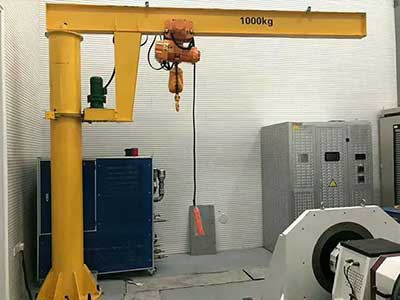
- Crane Design & Capacities: Slewing jib cranes, also known as wall-mounted or column-mounted jib cranes, have a horizontal jib arm that can rotate or slew.
- Tailored Features for Operation in Yemen: These cranes offer localized lifting capabilities with the ability to rotate, allowing for precise load positioning in various directions.
- Applicable Industries: Slewing jib cranes are commonly used in workshops, manufacturing units, and assembly lines where localized lifting is required.
- Typical Industrial Location & Crane Project Locations in Yemen: Found in areas where specific workstations or assembly points need controlled and precise lifting, often seen in manufacturing or maintenance areas.

Wall Jib Crane
- Crane Design & Capacities: Wall-mounted jib cranes are fixed to walls or vertical structures, offering limited but efficient lifting capabilities within a defined radius.
- Tailored Features for Operation in Yemen: These cranes are space-saving solutions, suitable for areas where floor space is restricted, providing a localized lifting solution.
- Applicable Industries: Wall jib cranes find use in smaller workshops, warehouses, or areas where floor space is limited but localized lifting is necessary.
- Typical Industrial Location & Crane Project Locations in Yemen: Utilized in smaller industrial setups, workshops, or areas with confined space limitations.

Floor Jib Crane
- Crane Design & Capacities: Floor-mounted jib cranes are fixed to the floor, offering a rotational arm for lifting within a specific area, often with a pillar support.
- Tailored Features for Operation in Yemen: These cranes offer flexibility in lifting within a designated area without the need for wall or ceiling support.
- Applicable Industries: Floor jib cranes are used in various industries where localized lifting or handling of materials is required within a specific workspace.
- Typical Industrial Location & Crane Project Locations in Yemen: Found in manufacturing units, maintenance areas, or workshops requiring localized lifting capabilities within a specific radius.
In Yemen's industrial context, where workspace limitations or specific localized lifting needs might exist, jib cranes provide tailored solutions for precise lifting within confined spaces or specific workstations. These crane types offer versatility and efficiency in various industries, especially where floor space or infrastructure constraints are present.
However, due to the dynamic nature of Yemen's industrial landscape and potential challenges arising from the ongoing situation, specific information about the presence or utilization of these crane types might vary. For precise details about the availability or usage of slewing jib cranes, wall jib cranes, and floor jib cranes in Yemen, consulting local crane suppliers, manufacturers, or industry experts familiar with the Yemeni market would provide the most accurate and current information.
Explosion-proof cranes and corrosion-resistant cranes are specialized types of overhead cranes designed to operate safely in hazardous or corrosive environments. Here are details about each:

- Crane Design & Capacities: Explosion-proof cranes are engineered with components and enclosures that prevent the ignition of flammable gases, vapors, or dust in potentially explosive atmospheres. They come in various lifting capacities to suit different industrial needs.
- Tailored Features for Operation in Yemen: These cranes are specifically designed to minimize the risk of sparks or ignition sources in environments where explosive materials or atmospheres exist.
- Applicable Industries: They are commonly used in petrochemical plants, refineries, chemical manufacturing, and other industries dealing with hazardous materials.
- Typical Industrial Location & Crane Project Locations in Yemen: Found in facilities where there's a potential risk of explosion due to the presence of flammable materials, especially in industrial settings like refineries or chemical plants.
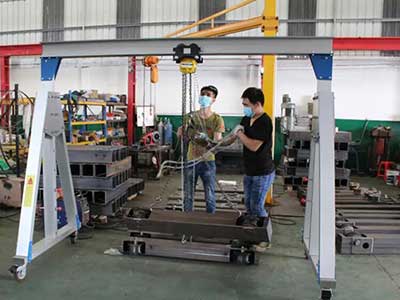
Corrosion-Resistant Crane
- Crane Design & Capacities: Corrosion-resistant cranes are built using materials and coatings that protect against rust, degradation, or damage caused by corrosive elements such as moisture, chemicals, or saline environments.
- Tailored Features for Operation in Yemen: These cranes are resistant to corrosion, making them suitable for use in environments where exposure to corrosive substances is prevalent, such as marine environments or chemical processing plants.
- Applicable Industries: Corrosion-resistant cranes are utilized in industries where there's exposure to corrosive elements, such as ports, shipyards, wastewater treatment plants, and chemical industries.
- Typical Industrial Location & Crane Project Locations in Yemen: Found in environments where exposure to corrosive agents like saltwater, chemicals, or humidity can deteriorate standard crane components.
In Yemen's industrial landscape, where certain industries might face environmental challenges or deal with hazardous materials, specialized cranes like explosion-proof and corrosion-resistant cranes are essential for safe and efficient operations. These crane types provide crucial safety measures and longevity in environments where standard cranes could be prone to damage or pose safety risks.
However, due to the specific nature of these cranes and the dynamic industrial conditions in Yemen, availability or detailed information regarding the presence of explosion-proof and corrosion-resistant cranes might require consulting with specialized crane suppliers, manufacturers, or industry experts familiar with the Yemeni market. They can offer precise details about the availability and suitability of these specialized cranes for specific industrial needs in Yemen.
Magnetic overhead cranes and grab bucket overhead cranes are specialized types of lifting equipment designed for specific material handling purposes. Here's a breakdown of each:

Magnetic Overhead Crane
- Crane Design & Capacities: Magnetic overhead cranes are equipped with electromagnetic lifting systems, allowing them to lift and transport ferrous materials using magnetic force. These cranes come in various lifting capacities based on the application's requirements.
- Tailored Features for Operation in Yemen: These cranes are designed to handle ferrous materials efficiently, eliminating the need for manual handling or separate lifting equipment.
- Applicable Industries: Magnetic overhead cranes find use in metalworking facilities, scrapyards, steel mills, and industries dealing with ferrous materials or scrap metal.
- Typical Industrial Location & Crane Project Locations in Yemen: Found in environments where there's a need to handle ferrous materials efficiently, such as metal fabrication units or scrapyards.

Grab Bucket Overhead Crane
- Crane Design & Capacities: Grab bucket overhead cranes are equipped with grab buckets or clamshell buckets designed to scoop and lift bulk materials like sand, gravel, coal, or other loose materials.
- Tailored Features for Operation in Yemen: These cranes provide an efficient way to handle loose bulk materials without the need for additional loading equipment.
- Applicable Industries: Grab bucket overhead cranes are used in industries dealing with loose bulk materials, including construction, mining, and ports for loading and unloading cargo.
- Typical Industrial Location & Crane Project Locations in Yemen: Seen in areas where bulk material handling is required, such as construction sites, mining operations, or ports for loading/unloading ships.
In Yemen's industrial landscape, where industries may involve the handling of various materials, these specialized cranes offer efficient and tailored solutions for specific material handling needs. Magnetic overhead cranes and grab bucket overhead cranes provide capabilities for handling ferrous materials or loose bulk materials, respectively, streamlining operations and enhancing productivity.
Due to the specific nature of these cranes and their application in material-specific industries, detailed information about their presence or utilization in Yemen might require consulting with specialized crane suppliers, manufacturers, or industry experts familiar with the Yemeni market. They can offer precise details about the availability and suitability of these specialized cranes for specific industrial needs in Yemen.
Applications of overhead cranes in Yeman

Agriculture
- Industrial Overview: Agriculture in Yemen involves cultivation of crops like coffee, qat, fruits, and vegetables.
- Location in Yemen: Agricultural activities are spread across fertile areas in regions such as Ibb, Taiz, and Al Hudaydah.
- Types of Overhead Cranes Used: Light-duty single girder overhead cranes for handling agricultural produce.
- Typical Crane Design & Capacity: Single girder cranes with moderate lifting capacities for loading/unloading bags of produce or equipment.
- Typical Functions and Application: Used in agricultural warehouses or processing facilities for lifting bags of produce or equipment.
- Typical Industrial Location and Crane Project Location in Yemen: Agricultural storage units, processing facilities, or marketplaces in agricultural regions.

Fishing Industry
- Industrial Overview: Yemen's fishing industry involves coastal and offshore fishing activities.
- Location in Yemen: Fishing activities are prominent in coastal cities like Aden, Al Hudaydah, and Mukalla.
- Types of Overhead Cranes Used: Gantry cranes for loading/unloading fishing vessels and handling fishery equipment.
- Typical Crane Design & Capacity: Gantry cranes with moderate lifting capacities for moving fishing gear or containers.
- Typical Functions and Application: Assists in transferring catch or fishing equipment from boats to onshore facilities.
- Typical Industrial Location and Crane Project Location in Yemen: Fishing ports, harbors, or dockyards along the coastal regions.

Oil and Gas (Energy Sector)
- Industrial Overview: Yemen possesses oil and gas reserves, contributing to its economy.
- Location in Yemen: Oil and gas operations are primarily in areas like Marib and Shabwah.
- Types of Overhead Cranes Used: Double girder overhead cranes for heavy lifting tasks in refineries or storage facilities.
- Typical Crane Design & Capacity: Double girder cranes with higher lifting capacities for handling heavy equipment or materials.
- Typical Functions and Application: Used in oil refineries or storage areas for moving heavy equipment or materials.
- Typical Industrial Location and Crane Project Location in Yemen: Oil refineries, storage yards, or drilling sites in regions associated with oil and gas extraction.
Factors to Consider When Choosing an Overhead Crane
Selecting the ideal overhead crane in Yemen involves a thoughtful assessment of several crucial factors. Here's a comprehensive look at key considerations to guide buyers towards making informed decisions:
Industrial Sector Requirements
Understanding the specific needs of your industry forms the foundation for choosing the right overhead crane. Whether it's the manufacturing sector requiring precise material handling or the construction industry needing heavy lifting capabilities, aligning the crane type with your industry's operational demands is paramount.
Lifting Capacity and Span
Determining the required lifting capacity and span plays a vital role in selecting an overhead crane. Whether it's a single girder crane for lighter loads or a double girder crane for heavier materials, ensuring the crane's capabilities match the operational requirements is essential for efficiency and safety.
Operational Environment (Space, Height, and Layout)
Assessing the operational environment in terms of available space, ceiling height, and layout constraints is crucial. Underhung bridge cranes or wall-mounted jib cranes might suit areas with limited overhead space, while gantry cranes offer outdoor handling solutions in varying environments across Yemen.
Safety Features and Compliance with Standards
Safety remains a paramount concern in industrial operations. Choosing an overhead crane that adheres to safety standards and is equipped with essential safety features like overload protection, emergency stop mechanisms, and proper operator training provisions is imperative for accident prevention and compliance.
Customization Options and Budget Considerations
Exploring customization options that align with specific operational requirements while considering budget constraints is essential. Whether it's specialized cranes for hazardous environments or tailored features for enhanced efficiency, balancing customization with budgetary considerations ensures an optimal investment.
In the upcoming sections of this guide, we'll delve into a comprehensive buying guide tailored for Yemeni buyers seeking customized overhead crane solutions. Stay tuned for expert insights into navigating the procurement process and securing the perfect overhead crane for your industrial needs in Yemen!
Buying Guide for Overhead Cranes in Yemen
Navigating the process of purchasing an overhead crane in Yemen involves strategic considerations and a systematic approach. Here's a comprehensive buying guide tailored to assist buyers in making well-informed decisions:
Identifying Your Specific Industrial Needs
Begin by precisely defining your industrial requirements and operational challenges. Determine the type of materials to be handled, the frequency of lifts, environmental conditions, and any specific safety or efficiency concerns unique to your industry. This clarity will guide your selection process toward the most suitable overhead crane solutions.
Evaluating Supplier Reliability and Expertise
Selecting a reputable and reliable supplier or manufacturer is critical. Evaluate the supplier's track record, industry experience, and expertise in providing overhead crane solutions. Assessing customer reviews, references, and past projects can offer insights into the supplier's reliability and the quality of their products and services.
Assessing Customization Options for Tailored Solutions
Discuss customization possibilities with the supplier to tailor the crane to your specific needs. Whether it involves adjusting lifting capacities, incorporating specialized features, or adapting the crane to unique operational environments, working closely with the supplier to customize the crane ensures it aligns perfectly with your requirements.
Cost Considerations and Budgeting for Purchase, Delivery, and Installation
Develop a comprehensive budget that accounts for the purchase cost of the crane, delivery charges, installation expenses, and any customization or additional service costs. Obtain detailed quotations from suppliers, ensuring transparency in pricing and any additional charges involved in the procurement process.
After-Sales Support and Maintenance Services
Prioritize suppliers offering robust after-sales support and maintenance services. Inquire about warranty periods, routine maintenance schedules, spare parts availability, and technical support post-installation. Establishing a strong support system ensures smooth operations and timely assistance in case of any issues or maintenance requirements.
Overview of Yemeni Market for Overhead Cranes
The Yemeni market for overhead cranes involves exploring various aspects that influence procurement decisions. Here's an overview to guide buyers in navigating the market:
Key Suppliers and Manufacturers in Yemen
In Yemen's overhead crane market, identifying reliable suppliers and manufacturers is a critical step in the procurement process. While the domestic market might have local suppliers catering to crane needs, exploring international suppliers with a presence or partnerships in Yemen can broaden the options available to buyers.
Domestic Suppliers
- Almutahid Industries Co. (AMICO): Known for their range of industrial equipment, AMICO offers overhead cranes tailored to diverse industrial needs in Yemen. Their expertise lies in providing solutions for various sectors, including manufacturing, construction, and logistics.
- Yemen Company for Elevators and Cranes: Specializing in crane and elevator systems, this local company provides a spectrum of crane solutions, including overhead cranes suitable for industrial applications across Yemen.
International Suppliers/Partnerships
- Konecranes: A globally recognized name in crane manufacturing, Konecranes has a network of partners or subsidiaries in several countries, including Yemen. Their expertise lies in offering a wide range of high-quality crane solutions for diverse industries.
- Demag Cranes: Renowned for their advanced crane technology and innovative solutions, Demag Cranes, through partnerships or regional offices, offers high-performance overhead cranes catering to various industrial sectors.
Researching Supplier Reliability, Product Quality, and Service
When considering suppliers, it's essential to research their reputation, product quality, and service reliability:
- Customer References: Seek references from other industries or businesses that have procured cranes from these suppliers to gauge their satisfaction with the product and service quality.
- Product Quality: Assess the quality certifications, standards adhered to, and the technology employed in the manufacturing process to ensure the crane's reliability and longevity.
- Service Reliability: Evaluate the supplier's after-sales service, maintenance support, spare parts availability, and response time for addressing issues, ensuring a smooth post-purchase experience.
By researching and evaluating these aspects, buyers can make informed decisions about choosing suppliers and manufacturers that best align with their industrial requirements and ensure a successful procurement of overhead cranes in Yemen.
Price Range and Competitive Pricing for Various Crane Models
Assessing the price range and competitive pricing for various crane models in Yemen aids in budget planning and decision-making. Factors influencing pricing include crane type, lifting capacity, customization, and additional features. Comparing prices among different suppliers ensures competitive pricing without compromising quality.
Factors Influencing Pricing
- Crane Type: Different types of cranes have varying price ranges. For instance, single girder overhead cranes generally have lower upfront costs compared to double girder cranes due to differences in design and lifting capacity.
- Lifting Capacity: The crane's lifting capacity significantly impacts its pricing. Cranes with higher lifting capacities are inherently more expensive due to the robust materials and engineering required to support heavier loads.
- Customization and Additional Features: Customizing cranes or adding specialized features tailored to specific industrial requirements can increase the overall cost. Features such as remote controls, advanced safety systems, and specialized materials for hazardous environments contribute to pricing variations.
- Quality and Brand Reputation: Established brands or manufacturers known for high-quality products might have a higher price range due to their reputation, reliability, and adherence to international standards.
Assessing Competitive Pricing
- Request for Quotations (RFQs): Reach out to multiple suppliers and request detailed quotations for the specific crane models and configurations that meet your industrial needs. Compare these quotations to gain insights into the competitive pricing landscape.
- Comparative Analysis: Conduct a comparative analysis of the quotations received, focusing on factors such as upfront costs, customization options offered, warranty periods, after-sales services, and any additional charges.
- Negotiation: Engage in negotiations with suppliers, especially if considering larger orders or long-term contracts. Sometimes, suppliers are willing to offer competitive pricing or additional services to secure a deal.
Budget Planning and Decision-Making
- Budget Allocation: Based on the price range assessed from quotations, allocate a budget that covers the crane's purchase cost, customization (if any), delivery charges, installation costs, and any potential contingencies.
- Value Proposition: Consider not only the upfront cost but also the value proposition offered by the crane. A slightly higher investment might be justified if it includes added features, quality assurance, and superior after-sales support.
By diligently assessing the price range and competitive pricing for various crane models, buyers in Yemen can make informed decisions that align with their budgetary constraints while ensuring they acquire high-quality overhead cranes that meet their specific industrial needs.
Import Regulations, Logistics, and Delivery Considerations
Navigating the intricacies of import regulations, logistics, and delivery is paramount, particularly when considering international suppliers for procuring overhead cranes in Yemen. Understanding the import procedures, taxes, duties, and logistics involved facilitates a smoother procurement process and helps mitigate potential challenges.
Import Regulations in Yemen
- Customs Documentation: Familiarize yourself with the required customs documentation for importing overhead cranes into Yemen. This may include invoices, packing lists, certificates of origin, and compliance certificates.
- Tariffs and Duties: Understand the applicable tariffs and import duties imposed on overhead cranes. These charges vary based on the crane type, value, and country of origin, impacting the overall procurement cost.
Logistics and Transportation
- Transport Modes: Determine the most suitable transportation mode for delivering the overhead cranes to Yemen. Options include sea freight, air freight, or land transportation based on factors such as urgency, cost-effectiveness, and the crane's size and weight.
- Shipping and Handling: Partner with reputable shipping companies or freight forwarders experienced in handling industrial equipment shipments to ensure safe and timely delivery. Coordinate with suppliers to arrange proper packaging, loading, and shipment tracking.
Delivery Considerations
- Lead Time: Account for lead times when planning the procurement schedule. Factor in production lead times, shipping durations, customs clearance, and potential delays to ensure timely arrival.
- Site Readiness: Ensure the site where the overhead crane will be installed is prepared and meets the necessary specifications before the crane's arrival. This includes infrastructure readiness, electrical requirements, and necessary clearances.
Mitigating Challenges
- Engage Local Expertise: Consider engaging local customs brokers, logistics providers, or consultants familiar with Yemen's import regulations and procedures to navigate potential hurdles efficiently.
- Anticipate Delays: Acknowledge that unforeseen delays due to customs clearance, documentation issues, or transportation disruptions might occur. Build contingencies into the procurement timeline to accommodate such situations.
Compliance and Legalities
- Compliance with Standards: Ensure that the imported cranes comply with Yemeni regulatory standards and certifications. Verify that the equipment meets safety, environmental, and operational regulations set by Yemeni authorities.
- By comprehensively understanding and proactively addressing import regulations, logistics intricacies, and delivery considerations, buyers can streamline the procurement process of overhead cranes in Yemen, ensuring smooth importation and successful installation at their industrial sites.
How to Order a Customized Specification Overhead Crane in Yemen
Ordering a customized overhead crane in Yemen involves a systematic approach that ensures the crane aligns perfectly with your industrial requirements. Here are the essential steps to facilitate a smooth ordering process:
Understanding Your Unique Requirements
Start by defining and documenting your specific requirements for the overhead crane. Consider factors such as lifting capacity, span, operational environment, safety features, and any specialized customization needed for your industrial operations in Yemen. This clear understanding forms the basis for crafting detailed specifications.
Collaborating with Suppliers for Customization Options
Engage in detailed discussions with potential suppliers, sharing your specific requirements and seeking their expertise for tailored solutions. Collaborate closely with suppliers to explore customization options, considering crane types, features, materials, and functionalities that align with your unique operational needs.
Reviewing and Finalizing Specifications and Features
Carefully review the proposed specifications and features provided by the supplier. Ensure that the proposed crane design, lifting capacities, safety features, and any specialized customization options meet your industrial requirements in Yemen. Clarify any doubts or concerns before finalizing the specifications.
Procurement Process, Order Placement, and Contract Terms
Initiate the procurement process by placing the order for the customized overhead crane. Work closely with the supplier to finalize contract terms, including delivery schedules, payment terms, warranty provisions, and any additional services agreed upon. Ensure clarity and mutual agreement on all terms before finalizing the purchase.
Case Studies or Examples of Successful Crane Installations in Yemen
Exploring real-world examples and case studies of successful overhead crane installations in Yemen provides valuable insights into their practical applications and impact across various industries:
Real-World Applications of Different Crane Types in Yemeni Industries
- Oil and Gas Sector: Double girder overhead cranes employed in Marib's oil fields, facilitating efficient material handling and equipment maintenance.
- Manufacturing Units: Single girder overhead cranes utilized in Sana'a's manufacturing plants, streamlining assembly line processes and enhancing productivity.
- Construction Sites: Gantry cranes, both semi and portable types, contributing to the efficient handling of construction materials at various building sites across Yemen.
Testimonials or Feedback from Buyers on Crane Performance
The double girder overhead crane we purchased significantly improved our operations. Its robust design and lifting capacity exceeded our expectations, enhancing our efficiency. - Testimonial from a buyer in the construction industry.
The customized features of the gantry crane have immensely helped in maneuvering materials across our warehouse efficiently. The supplier's support has been exceptional.
Feedback from a buyer in a logistics facility.
Impact on Efficiency and Productivity in Specific Industrial Settings
- The implementation of top running overhead cranes in manufacturing units led to a notable increase in production output by streamlining material handling processes.
- Introduction of specialized grab bucket overhead cranes in port facilities significantly reduced loading and unloading times, enhancing overall operational efficiency.
These case studies demonstrate how diverse types of overhead cranes cater to specific industrial needs in Yemen, enhancing operational efficiency and productivity across various sectors.
Conclusion
As we conclude this comprehensive guide, let's recap the key considerations and emphasize the importance of making informed decisions when purchasing overhead cranes in Yemen:
- Industrial Needs: Understand and document your specific industrial requirements for the crane type, lifting capacity, operational environment, and safety features.
- Supplier Evaluation: Thoroughly evaluate supplier reliability, expertise, customization options, and after-sales support before finalizing the purchase.
- Customization and Budget: Collaborate closely with suppliers to customize the crane while balancing budgetary considerations to ensure a perfect fit for your operations.
Empowering yourself with knowledge and insights about overhead crane types, market dynamics, and the procurement process is crucial. Engage with reputable suppliers, conduct due diligence, and explore available options to make informed decisions that align with your industrial needs in Yemen.
Selecting the right overhead crane is pivotal for optimized operations in Yemeni industries. The ideal crane type, customized to meet specific requirements, not only enhances efficiency and productivity but also ensures safety compliance, contributing to the overall success of industrial operations.
By applying the insights and guidelines provided in this comprehensive guide, buyers in Yemen can navigate the complexities of purchasing overhead cranes effectively, securing the perfect crane solution tailored to their industrial needs.
We hope this guide has been instrumental in aiding your decision-making process and wish you success in acquiring the ideal overhead crane for your operations in Yemen!
Main Projects
Related Products

Supplied three grab bucket crane kits to Indonesia, enhancing garbage handling efficiency with high load capacity and reliable performance.
Free consultation to Confirm Parameters & Specifications and Get
Latest Crane Price & Crane Rate.
- Types of overhead cranes : _______?
- Optional: Overhead travelling crane, goliath gantry crane,Slewing jib crane, Single girder or double girder crane,small portable crane or kbk crane, etc.
- Capacity of overhead crane: _______?
- Optional: 0.25ton, 0.5 ton, 1 ton, 2 ton, 3ton, 5 ton, 10 ton,15ton, 20ton, 25 ton, 30ton,35ton, up to 550ton, etc.
- Crane span & lifting height : _______?
- Crane travelling length : _____?
- Control of overhead crane:_______?
- Optional: pendant/ remote/cabin control
- Voltage supply of overhead crane:_____?
- Eg,: 380V50/60HZ,3Phase or others,etc.
- Application/usage of crane:_______?
- Eg,: Steel mill, ,injection mold, cement,stone, concrete,granite, general manufacturing, etc.
Just leave a message via the contact form and our hoist and crane engineer will contact you with in 24working hours.
Get In Touch
